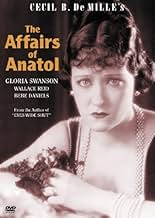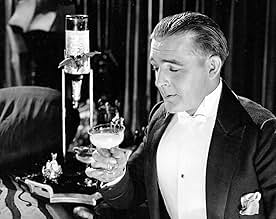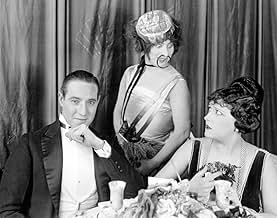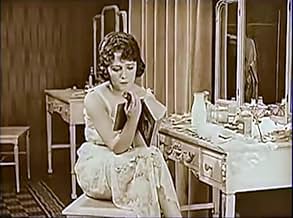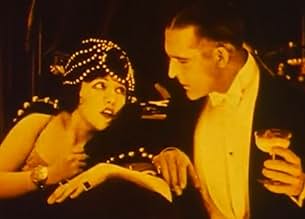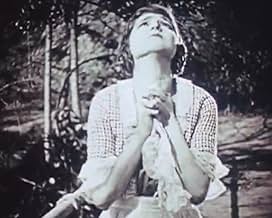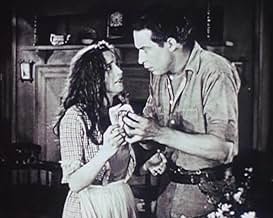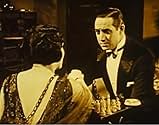CALIFICACIÓN DE IMDb
6.6/10
1.4 k
TU CALIFICACIÓN
Agrega una trama en tu idiomaSocialite Anatol Spencer seeks a better relation than he has with his wife. He sets up the friend of his youth Emilie in an apartment and she two-times him; he comforts near-suicidal Annie a... Leer todoSocialite Anatol Spencer seeks a better relation than he has with his wife. He sets up the friend of his youth Emilie in an apartment and she two-times him; he comforts near-suicidal Annie and she robs him.Socialite Anatol Spencer seeks a better relation than he has with his wife. He sets up the friend of his youth Emilie in an apartment and she two-times him; he comforts near-suicidal Annie and she robs him.
- Dirección
- Guionistas
- Elenco
- Premios
- 1 premio ganado en total
Laura Anson
- Vivian's Maid
- (sin créditos)
Alma Bennett
- Chorus Girl
- (sin créditos)
William Boyd
- Guest
- (sin créditos)
Shannon Day
- Chorus Girl
- (sin créditos)
Julia Faye
- Tibra
- (sin créditos)
Elinor Glyn
- Bridge Player
- (sin créditos)
Winter Hall
- Dr. Johnston
- (sin créditos)
Raymond Hatton
- Great Blatsky - Violin Teacher
- (sin créditos)
Fred Huntley
- Stage Manager
- (sin créditos)
- Dirección
- Guionistas
- Todo el elenco y el equipo
- Producción, taquilla y más en IMDbPro
Opiniones destacadas
Drawn to this by the irresistable and rare chance of seeing Wallace Reid and Gloria Swanson working together on a film, I had heard about it through reference books (and also about Swanson's recollections of the film not being happy due to feeling uncomfortable with Reid at the time), and expected exactly what I got - a fun piece with some nice touches (Gloria's playful mood before she feels slighted by Wanda Hawley's flapper girl; Reid trashing Hawley's apartment when he realises she did not have pure intentions towards him after all; Agnes Ayres and Reid sharing a kiss in the woods while Gloria has gone to fetch a doctor to attend to Ayres, 'half-drowned' when she left; and best of all, Bebe Daniels as the absurdly named Satan Synne who is really a domesticated pussy cat chasing young men for cash to help her sick husband). The Affairs ... also benefits from having a lovely series of colour tints throughout. A little overlong perhaps (and too much focus on Hawley at the expense of the other girls encountered by Tony) but another fascinating early piece from De Mille. Sad to think that Wallace Reid would be dead by early '23. The movies' loss.
I know some may find me an oddball for this but I consider The Affairs of Anatol a masterpiece of silent cinema.
Gloria Swanson is one of my favorite actresses and she's remarkable as always in this one. But I wouldn't see Affairs for just her alone, her part is rather small compared to the ones she had in Don't Change Your Husband and Why Change Your Wife? However, even though she doesn't get as much screen time, she's still amazing and in my honest opinion, she steals every scene she's in. Her elegant wardrobe and sophisticated aura makes her the star. Wallace Reid is great too and watching him, you never would have guessed he was towards the end of his life. He seemed very strong and handsome to me, although I haven't seen him in much (sadly).
Anatol (Reid) and his wife, Vivian (Swanson) are a pretty happy married couple until Anatol starts developing the habit of wanting to rescue women with no morals from their fate. This film is long but it HAS to be to fit it all in! We travel with Anatol and Vivian through many adventures that continuously test their marriage and happiness.
The cast is absolutely fabulous! Many, many good actors and actresses here. Obviously, Gloria Swanson and Wallace Reid. Then we have delightful Bebe Daniels as Satan Synne, a vampish woman with a heart of gold deep down. Also, there's the wonderful, unique and sadly underrated Raymond Hatton who has a short appearance as a violin teacher. Pretty and talented Agnes Ayres plays a country "good girl" and the great character actor Theodore Roberts plays a mean ol' millionaire. Others in the cast worth mentioning are Monte Blue, Wanda Hawley, Elliott Dexter and Theodore Kosloff.
This movie is stunning visually and is gorgeous to look at. Beautiful tints and a score that works with the film like butter works with bread. The costumes and sets are to die for and the whole thing just screams DeMille. TCM shows this film every now and then but I wouldn't wait that long. For Gloria and DeMille fans this is a MUST.
Gloria Swanson is one of my favorite actresses and she's remarkable as always in this one. But I wouldn't see Affairs for just her alone, her part is rather small compared to the ones she had in Don't Change Your Husband and Why Change Your Wife? However, even though she doesn't get as much screen time, she's still amazing and in my honest opinion, she steals every scene she's in. Her elegant wardrobe and sophisticated aura makes her the star. Wallace Reid is great too and watching him, you never would have guessed he was towards the end of his life. He seemed very strong and handsome to me, although I haven't seen him in much (sadly).
Anatol (Reid) and his wife, Vivian (Swanson) are a pretty happy married couple until Anatol starts developing the habit of wanting to rescue women with no morals from their fate. This film is long but it HAS to be to fit it all in! We travel with Anatol and Vivian through many adventures that continuously test their marriage and happiness.
The cast is absolutely fabulous! Many, many good actors and actresses here. Obviously, Gloria Swanson and Wallace Reid. Then we have delightful Bebe Daniels as Satan Synne, a vampish woman with a heart of gold deep down. Also, there's the wonderful, unique and sadly underrated Raymond Hatton who has a short appearance as a violin teacher. Pretty and talented Agnes Ayres plays a country "good girl" and the great character actor Theodore Roberts plays a mean ol' millionaire. Others in the cast worth mentioning are Monte Blue, Wanda Hawley, Elliott Dexter and Theodore Kosloff.
This movie is stunning visually and is gorgeous to look at. Beautiful tints and a score that works with the film like butter works with bread. The costumes and sets are to die for and the whole thing just screams DeMille. TCM shows this film every now and then but I wouldn't wait that long. For Gloria and DeMille fans this is a MUST.
Cecil B. DeMille, it would appear, had a bit of a thing about ladies' feet. This may partly explain why the first glimpse we catch of Gloria Swanson in the Affairs of Anatol, is a close-up of said body part – bare, exquisitely framed, and being treated to a pedicure.
However, it was very much the DeMille way to introduce his characters in bits, summing them up by focusing us on some tiny yet significant feature. Shortly before the entrance of Miss Swanson's foot, we meet Wallace Reid's impatiently shuffling boots and tapping fingers. By doing this DeMille gives us an impression of the man before we even see his face. And throughout this picture, we can see DeMille has a kind of "inside-out" approach to shooting a scene. Cinematic convention, even back then, was generally to start with a master shot, then draw us in on the details. DeMille begins with the minutiae, then gradually reveals the bigger picture. Take the dancehall sequence where Reid meets the subject of his first affair. We first of all see Reid's view of Wanda Hawley, as if she were seated alone at the table. It is only after her character has been established that we see a shot from a little further back, showing us she is in the company of a lecherous old Theodore Roberts! DeMille's process of gradual revelation especially applies to the splendour of a set, such as the giant fan being pulled aside to reveal a stunning backdrop of stars later in the same scene.
The purpose of all this is not only to make the picture visually attractive and smoothly paced. DeMille was one of the best at this time when it came to representing the thoughts of his characters. When Reid first sets eyes on Hawley, she really is all he can see, with Roberts being an unimportant distraction. At any one time, DeMille is showing us the focus of the protagonists, without often resorting to anything so subjective as a point-of-view shot. It is a subtler equivalent to the superimpositions of imagined figures or objects that he employed in his earlier pictures. With this canny cinematic approach you'd hardly know you were seeing an adaptation of a thirty-year old stage play.
Speaking of which, the original Affairs of Anatol was a popular comedy, and the jokes in theatre productions tend to be in the words, so how to translate it to the silent screen and keep in the comedy? DeMille was no master of slapstick, and his cast were certainly no clowns. However what remains from the original is a kind of growing sense of unlikely silliness, as opportunities for adultery continually appear in Reid's path, only to be flattened by unexpected twists. The world in which the story takes place is so shallow and dignified that these daft situations – slight exaggerations of typical melodramatic plot turns – just about pass for humour.
But the fact that it works at all is largely down to the efforts of the cast. Wallace Reid goes through it all with such po-faced seriousness, and the sober and dedicated manner in which he undertakes his infidelity is actually rather funny. The highlight is surely the appearance of Agnes Ayres and Monte Blue, who act out their little slice of melodrama without even a pretence of sincerity. It is perhaps the most frivolous moment of any DeMille film, and given its place among the familiar DeMille trappings, even Ayres jumping in the river in a suicide attempt looks like a gag.
Sadly, the only cast member who does not seem quite at home here is Gloria Swanson. She is essentially an air-headed young bride, giving her errant husband an unfeasible number of chances, and frankly the role is beneath her. Here and there she gets to show her powerful dramatic presence, but she becomes a somewhat marginal figure as the titular affairs take centre stage, and her talents are largely wasted. After giving impressive turns in several of his biggest hits, this was to be the last of her collaborations with the director. It seems that in DeMille's eyes, Swanson had become little more than a beautiful pair of feet.
However, it was very much the DeMille way to introduce his characters in bits, summing them up by focusing us on some tiny yet significant feature. Shortly before the entrance of Miss Swanson's foot, we meet Wallace Reid's impatiently shuffling boots and tapping fingers. By doing this DeMille gives us an impression of the man before we even see his face. And throughout this picture, we can see DeMille has a kind of "inside-out" approach to shooting a scene. Cinematic convention, even back then, was generally to start with a master shot, then draw us in on the details. DeMille begins with the minutiae, then gradually reveals the bigger picture. Take the dancehall sequence where Reid meets the subject of his first affair. We first of all see Reid's view of Wanda Hawley, as if she were seated alone at the table. It is only after her character has been established that we see a shot from a little further back, showing us she is in the company of a lecherous old Theodore Roberts! DeMille's process of gradual revelation especially applies to the splendour of a set, such as the giant fan being pulled aside to reveal a stunning backdrop of stars later in the same scene.
The purpose of all this is not only to make the picture visually attractive and smoothly paced. DeMille was one of the best at this time when it came to representing the thoughts of his characters. When Reid first sets eyes on Hawley, she really is all he can see, with Roberts being an unimportant distraction. At any one time, DeMille is showing us the focus of the protagonists, without often resorting to anything so subjective as a point-of-view shot. It is a subtler equivalent to the superimpositions of imagined figures or objects that he employed in his earlier pictures. With this canny cinematic approach you'd hardly know you were seeing an adaptation of a thirty-year old stage play.
Speaking of which, the original Affairs of Anatol was a popular comedy, and the jokes in theatre productions tend to be in the words, so how to translate it to the silent screen and keep in the comedy? DeMille was no master of slapstick, and his cast were certainly no clowns. However what remains from the original is a kind of growing sense of unlikely silliness, as opportunities for adultery continually appear in Reid's path, only to be flattened by unexpected twists. The world in which the story takes place is so shallow and dignified that these daft situations – slight exaggerations of typical melodramatic plot turns – just about pass for humour.
But the fact that it works at all is largely down to the efforts of the cast. Wallace Reid goes through it all with such po-faced seriousness, and the sober and dedicated manner in which he undertakes his infidelity is actually rather funny. The highlight is surely the appearance of Agnes Ayres and Monte Blue, who act out their little slice of melodrama without even a pretence of sincerity. It is perhaps the most frivolous moment of any DeMille film, and given its place among the familiar DeMille trappings, even Ayres jumping in the river in a suicide attempt looks like a gag.
Sadly, the only cast member who does not seem quite at home here is Gloria Swanson. She is essentially an air-headed young bride, giving her errant husband an unfeasible number of chances, and frankly the role is beneath her. Here and there she gets to show her powerful dramatic presence, but she becomes a somewhat marginal figure as the titular affairs take centre stage, and her talents are largely wasted. After giving impressive turns in several of his biggest hits, this was to be the last of her collaborations with the director. It seems that in DeMille's eyes, Swanson had become little more than a beautiful pair of feet.
THE AFFAIRS OF ANATOL, which are really only his attempts to help unhappy or wayward women, has left his own marriage in a very precarious predicament.
During the 1920's, director Cecil B. DeMille became famous for two types of film - the lavish historical spectacle & the elaborate, somewhat salacious, social comedy. ANATOL is an example of the latter. While its plot is insignificant (and faintly ludicrous), it is still quite enjoyable to watch, and can boast of fine performances & superior production values.
In the title role, Wallace Reid acquits himself very well as the hapless rich chump whose noble deeds always seem to backfire. Good-natured & affable, he is only too susceptible to damsels in distress. But even this worm can turn, and his violent scenes - laying waste the apartment of a mendacious maiden, crashing into his wife's locked boudoir - show the energy & passion of which this nearly forgotten star was capable.
Gloria Swanson, as Reid's lively spouse; Wanda Hawley as a millionaire's courtesan; Agnes Ayres as a duplicitous country wife; and diabolic Bebe Daniels as the ultimate vamp, all add greatly to the enjoyment of the proceedings, slinking about in fashions (all except Miss Ayres) only crazy movie folk of the 1920's could ever truly get by with.
Movie mavens will have no trouble spotting the irrepressible Polly Moran as a zany nightclub orchestra leader.
A Wallace Reid film is a rather rare & wonderful thing now, as most of them seem to have vanished long ago. Reid, immensely popular in his day, was the epitome of the American Hero. Tragically, his story became a living nightmare. Injuries received while on location in Oregon in 1919 left him seemingly unable to complete his role. The Paramount Studio doctor was dispatched to plug him full of morphine and put him back in front of the cameras. It worked, but already weakened by alcoholism, Reid now became a helpless morphine addict. His problem was an open secret in Hollywood, but instead of the real help he desperately needed, he was given more of the deadly drug. His box office returns were considered too valuable, and the Studio pushed him through an insufferable number of films - 7 in 1921, 8 in 1922. After ANATOL, in which it was becoming obvious that his good looks were beginning to decay, Reid made 11 more films in increasing agony. His death on January 18, 1923, was officially attributed to the influenza which finally overcame the body debilitated by alcohol & drug addiction. Wallace Reid was only 31 years old.
During the 1920's, director Cecil B. DeMille became famous for two types of film - the lavish historical spectacle & the elaborate, somewhat salacious, social comedy. ANATOL is an example of the latter. While its plot is insignificant (and faintly ludicrous), it is still quite enjoyable to watch, and can boast of fine performances & superior production values.
In the title role, Wallace Reid acquits himself very well as the hapless rich chump whose noble deeds always seem to backfire. Good-natured & affable, he is only too susceptible to damsels in distress. But even this worm can turn, and his violent scenes - laying waste the apartment of a mendacious maiden, crashing into his wife's locked boudoir - show the energy & passion of which this nearly forgotten star was capable.
Gloria Swanson, as Reid's lively spouse; Wanda Hawley as a millionaire's courtesan; Agnes Ayres as a duplicitous country wife; and diabolic Bebe Daniels as the ultimate vamp, all add greatly to the enjoyment of the proceedings, slinking about in fashions (all except Miss Ayres) only crazy movie folk of the 1920's could ever truly get by with.
Movie mavens will have no trouble spotting the irrepressible Polly Moran as a zany nightclub orchestra leader.
A Wallace Reid film is a rather rare & wonderful thing now, as most of them seem to have vanished long ago. Reid, immensely popular in his day, was the epitome of the American Hero. Tragically, his story became a living nightmare. Injuries received while on location in Oregon in 1919 left him seemingly unable to complete his role. The Paramount Studio doctor was dispatched to plug him full of morphine and put him back in front of the cameras. It worked, but already weakened by alcoholism, Reid now became a helpless morphine addict. His problem was an open secret in Hollywood, but instead of the real help he desperately needed, he was given more of the deadly drug. His box office returns were considered too valuable, and the Studio pushed him through an insufferable number of films - 7 in 1921, 8 in 1922. After ANATOL, in which it was becoming obvious that his good looks were beginning to decay, Reid made 11 more films in increasing agony. His death on January 18, 1923, was officially attributed to the influenza which finally overcame the body debilitated by alcohol & drug addiction. Wallace Reid was only 31 years old.
An interesting document of almost one hundred years ago. Your enjoyment of this will obviously depend on whether you like silents or not. As a look way back to the beginnings of narrative film making and a fashion show of what woman wore then this has some interest. Gloria is unquestionably the star and she holds the screen with no problem. A renown clotheshorse her outfits are bizarre in the extreme to the modern eye but were the height of high fashion in their day. It's also a rare chance to see the doomed Wallace Reid in one of his few existing films. He was deep in the throes of the morphine addiction that would kill him within two years when this was made and looks shockingly old when you realize he was only 29 at the time, he appears 50 minimum.
¿Sabías que…?
- TriviaGloria Swanson admitted in an interview decades later that Wallace Reid's drug addiction scared her while they were making this film, and she avoided socializing with him because of it.
- ErroresIn the flashback sequence where Emilie is on a swing and two mirrors are set up to give repeated reflections of the action, the cameraman bending over his camera is visible a few times when the swing moves out of the way.
- Citas
Anatol Spencer: Let's not kiss any more, dear, until after breakfast.
- Versiones alternativasFilm Preservation Associates copyrighted a version in 1999 with a music score compiled and performed by Brian Benison. It was produced for video by David Shepard and ran 117 minutes.
- ConexionesEdited into Don't Tell Everything (1921)
Selecciones populares
Inicia sesión para calificar y agrega a la lista de videos para obtener recomendaciones personalizadas
Detalles
- Tiempo de ejecución
- 1h 57min(117 min)
- Mezcla de sonido
- Relación de aspecto
- 1.33 : 1
Contribuir a esta página
Sugiere una edición o agrega el contenido que falta

